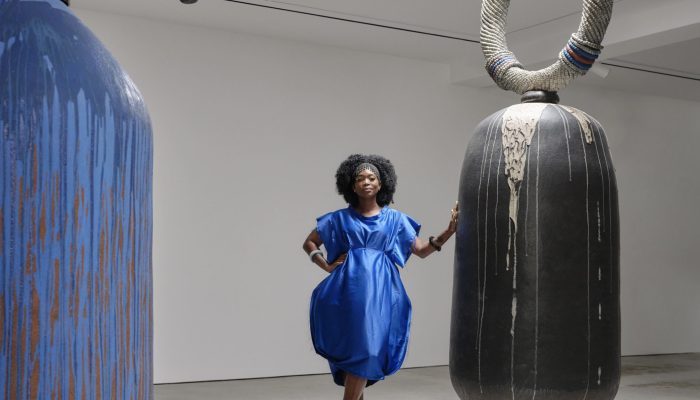
Zizipho Poswa upscales objects of African beautification and ritual in this series of monumental sculptures. Precious metal jewellery, beadwork, hair combs and pins made by master artisans across the continent are emulated as bronze-cast elements resting atop vast ceramic silos, revering and immortalising the valued positions these amulets hold.
Indyebo yakwaNtu (Black Bounty) is Zizipho Poswa’s most ambitious technical undertaking to date, comprising five colossal ceramic and bronze sculptures reaching heights of over 8 feet tall. The clay bodies were produced during her summer-long residency at the Center for Contemporary Ceramics (CCC) at California State University Long Beach, where Poswa had access to the centre’s immense kilns.
She worked under the guidance of renowned American ceramic artist Tony Marsh, co-founder and inaugural director of the CCC, which functions as an influential hub for expanded discourse and advanced creative production in the West Coast ceramics community. Poswa joins the more than 200 artists from 20 countries who have been invited guests at the centre, including Magdalene Odundo, Simone Leigh, Akio Takamori, and Morten Løbner Espersen.
In this new body of work, Poswa consciously upscales objects of African beautification and ritual. Precious metal jewellery, beadwork, hair combs and pins made by master artisans across the continent are emulated as bronze-cast elements resting atop vast ceramic silos, revering and immortalising the valued positions these amulets hold.
Translated from Xhosa, “indyebo” literally refers to material riches but more broadly encompasses the cultural, economic, intellectual and spiritual wealth of Africans. “Ntu” is the spirit that defines and gives impetus – an embodiment of the identity, consciousness and life purposes of African beings. Indyebo yakwaNtu is, therefore, a fulfilment of Poswa’s ancestral mission to celebrate both the natural and self-producing beauty of the continent.
Her approach in this body of work is distinctly Pan-African: “Drawing on Africa’s own mineral wealth, her people have created an immeasurable creative collection from which African men and women adorn themselves, resulting in a language of objects that has come to shape our identity,” Poswa says.
With their bronze crowns, this series of sculptures stands as a praise song to early African civilisations. Poswa traces the traditional healing customs, polytheistic practices and cosmological knowledge of her amaXhosa culture to its Kemetic heritage. The influence of the Nubian kingdom – rich in gold, ivory and ebony – spread along the Nile from Eqypt to Sudan, South Sudan, Uganda and Ethiopia and through trade routes, human migration and nomadic cultures to the Swahili civilisation in Mozambique, the Sahara of Northern Africa, and the Southern African region where Poswa finds her home.